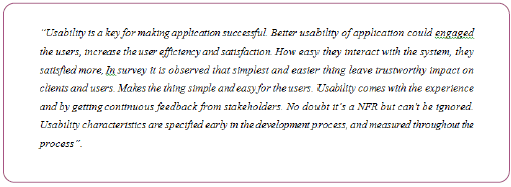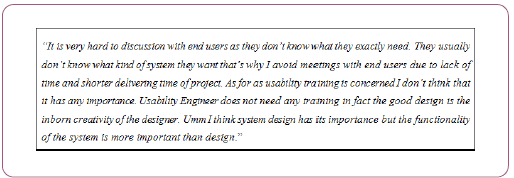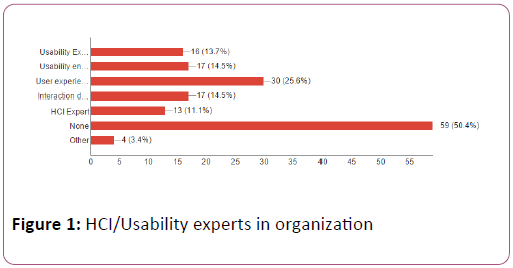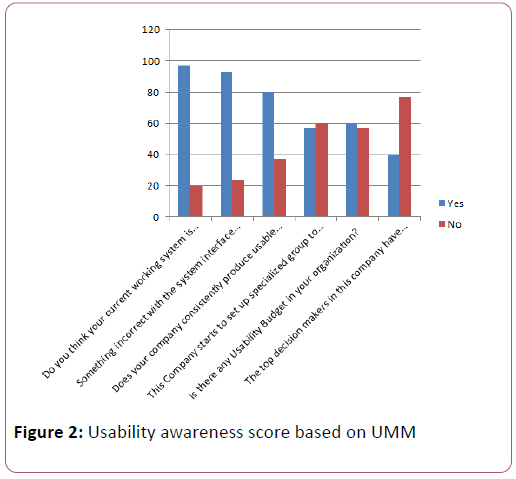ISSN : 2349-3917
American Journal of Computer Science and Information Technology
Perception of IT Professionals
Lal Khan1* and Mahmood Ashraf2
1Department of Computer Science and IT, University of Lahore, Pakistan
2Department of Computer Science, Federal Urdu University of Science, Arts and Technology, Islamabad, Pakistan
- *Corresponding Author:
- Lal Khan
Department of Computer Science and IT, University of Lahore, Pakistan
E-mail: lal.khan.buzdar@gmail.com
Received date: January 02, 2018; Accepted date: January 06, 2018; Published date: January 10, 2018
Citation: Khan L, Ashraf M (2018) Perception of IT Professionals about Usability Awareness. Am J Compt Sci Inform Technol 6:1. doi: 10.21767/2349-3917.100012
Copyright: © 2018 Khan L, et al. This is an open-access article distributed under the terms of the Creative Commons Attribution License, which permits unrestricted use, distribution, and reproduction in any medium, provided the original author and source are credited.
Abstract
Usability gets more attention by IT Experts and scholars throughout the world but it is very limited in Pakistan. This study reports a survey result of perceptions of IT professionals about usability and current state of usability awareness in the Information Technology (IT) industry of Pakistan. 117 participants were involved in the survey studies who are working in IT industry of Pakistan. By using Usability Maturity Model (UMM), results reveals that most of the IT companies are at unrecognized level of UMM. Finding indicates that there is a major difference on the usability awareness, perceptions between Software Engineers and Software Developers. Finding also indicates that end users were not involved in product designing phase. Most of the System Analysts and Software Developers have shown no interest in usability. Most of the Software Developers do not know about usability, in-fact they are confused about usability. Dearth of HCI/Usability Experts is witnessed. Most organizations are not interested in usability because they have no financial budget for it.
Keywords
Human-computer interaction (HCI); Usability; Usability awareness; HCI practitioners; Pakistan IT industry
Introduction
The Special Interest Group on HCI of the Association for Computing Machinery (ACM) describe HCI as discipline concerned with the design, evaluation and implementation of interactive computing systems for human use and with the study of major phenomena surrounding them (SIGCHI Curriculum Development Group). To aid human’s physical and mental abilities for developing technology HCI Knowledge has seemed as an essential requirement [1]. From 1980 in IT industry of United States and Europe, HCI is considered very important [2]. HCI is the Practice and study of Usability [3].
Usability is a measurable feature of a product’s e.g. easy to use and learn [3]. Usability is a quality features of the complete system not only the features of the user interfaces [4]. When transitions turned towards windows, Internet and smart mobile phones Usability become very significant attribute of the system. Now scholars are paying a massive consideration on usability throughout the World [5].
Usability awareness is a phenomenon that is keen on usability features; learnability, efficiency, memorability, errors and satisfaction. Eight levels of usability identified by Jakob Nileson called them the levels of organization usability maturity to be implemented by an organization during product developing phase. Assurance of Usability on projects can be increased by executing the 8 stages, after applying the 8 stages the system will become usable enough that the user need no training for using the system [6].
In difference with developed countries, Pakistan current status as in HCI and usability is developing. However, the IT revolution in Pakistan is clearly coming of age, encouraged by the usage of Internet and falling price of telecommunication. Therefore, we are conducting this research to find the current state of HCI/Usability in Pakistan IT industry.
This paper is divided into seven sections. First section introduces the study. The 2nd section describes the Literature review. Third part of the paper explains the methodology. Data analysis is explained in fourth section of the paper. Results of this study are presented in section five. Sixth section of this paper contains the discussions and last section of the paper contains the conclusion of this paper.
Litreature Review
A survey study was conducted in Malaysia. Total Seventy-two respondents were participated in this study, 23 of them were IT practitioners, 27 of them were IT students and 22 of them were non-IT practitioners. The participants were system analysts, sales men, software developers, marketing persons and IT students. Outcomes of the study show that there is no big difference on usability awareness between IT Experts, non-IT practitioners and IT students. Results reveal that usability is considered as God gifted skills and common-sense knowledge for both IT and Non-IT staff. Organizations were considered at unrecognized level of usability. Usability Maturity Model was used to find the current state of awareness of an organization [7].
Collaboration between academia and industry considered Vitol for better perceptions about HCI. HCI Experts are requested from IT industry in universities to convey the real view of HCI to students. At postgraduate and undergraduate level HCI considered as an important subject in Malaysia. MIMOS Berhad is government agency concentrating on the cooperation among industry and academia. Through MIMOS offering internship to students, deliver lectures and evaluating student’s projects are included in collaboration between industry and academia. To promote HCI these initiatives are required to be taken by the whole Malaysian industry [6].
Another survey was conducted in UAE where the participants were IT managers and end users. Finding reveals that the participants do not think that usability related issues are existing. Usability of the system was not considered an important factor. They do not have knowledge about usability and HCI. Lacks of usability staff were witnessed. End users were not involved in designing phase of the system [6].
A survey was conducted in Korea. A total of 72 respondents were involved in this survey study. The respondents were development practitioners and UI/Usability practitioners. Lack of usability staff and lack of usability methods were identified. Findings show that usability is not applied on products [8].
Topmost Chinese organizations recognized User Experience (UX) as a basic issue. These most leading Chinese organizations have their private research laboratories and Usability Engineering staff. About 200 HCI/Usability Experts are employed in these laboratories [9].
Most recently a survey was conducted in Pakistan IT industry to find out the current state of awareness of usability of an organization. Most of the participant were in this survey study were from open software houses. It was pilot survey study 1 conducted by the same author. Data was analysed on the basis of UMM. After completion of study 1 the 2nd survey study was started and PSEB registered, not registered firms were included in this current study. The result of the survey study [10] one reveals that software developers were found confused about usability and not interested in HCI or usability related issues. Most of the respondents do not consider usability an important software factor. Usability awareness levels of experienced and non-experienced IT professionals were equal. In most of the organizations end user were not involved in user interface designing phase of the product. Lack of HCI or usability staff were witnessed in most of the organizations. Most of the organizations were categorized at unrecognized level of UMM.
Methodology
Different usability maturity evaluation models have been proposed. To find out usability awareness in a corporation, this study is planned using the Usability Maturity Model (UMM) briefly explained in Table 1. Latest studies [11] in Asia have adopted the UMM to find the level of usability awareness in a company.
Respondents profile
A Total 117 respondents took part in the study.
Respondents were Developers (Android, IOS, Web, and Computer System), Software Engineers, Quality Assurance Engineers, Managers, Internees, Designers, Software Analysts, Senior Executives and CEOs.
Among the respondents; One Hundred-one (86.3%) were male and 16 (13.7%) were female.
As many as ninety-seven (82.9%) respondents were from 30 years or less age group. Nineteen 16.2% respondents were from 31 to 40 years age group. Only 1 respondent was from more than 60 years age group.
Eighteen (45%) respondents were bachelor degree holders. Master degree holders were 19 (47.5%) and only 2 (5%) respondents were MS degree holders. Only one respondent has Intermediate level of education. All the participants have computer science or software engineering academic background.
Thirty-Four (29.1%) respondents have one year professional experience. Twenty-Seven (23.1%) respondents have two years’ experience. Nineteen 19 (16.2%) respondents have five years’ experience. Fourteen (12%) participants have three years working experience in their current job. Twelve (10.3%) participants had four years’ experience. Six (5.1%) respondents had a ten years job experience. Five 5 (4.3%) participants have more than ten years of experience.
Design
An online questionnaire was designed and sent to focus group. Most of the questions in questionnaire were closedended, which are followed by response options. However, some open ended-questions are also asked in the questionnaire to explore the views of the respondents. Following six questions were included in the questionnaire to find out the current state of usability of an organization according to UMM.
• Q#1: Do you think your current working system is usable?
• Q#2: Something incorrect with the system interface but not sure what was the issue and don’t know how to fix it.
• Q#3: Does your company consistently produce usable products?
• Q#4: This Company starts to set up specialized group to handle user interface issues.
• Q#5: Is there any Usability Budget in your organization?
• Q#6: The top decision makers in this company have started focusing on design for human use rather than inner technology.
Live interviews were also held with some IT experts. However, open-ended and same questions were asked during the interview.
Perceptions of IT professionals about usability

Comments of a senior software engineers about usability are mentioned below. He had More than 5 years of experience and sixteen years of education.

Usability maturity model (UMM)
To figure out the usability awareness level of any organizations UMM is used. UMM is explained in Table 1.
| Level UMM | Process Attributes | Explanation |
|---|---|---|
| Level X: Unrecognized |
No Indicators | At Unrecognized level of UMM the employees in a company think that product they have Developed having no problem regarding usability of that product. |
| Level A: Recognized |
Problem recognition | When employs of an organization identify problems regarding usability in their developed product and it need to be improve its usability. |
| Performed process | Members of an organization know that Usability covers whole system. does not concern only with interface, which is used by end user, but it | |
| Level B: Considered |
Quality in use awareness | Employees know that quality of product comes through the series of HCI process by collecting the end user requirements. |
| User focus | Keeping an eye during developing product that end user is not technical as compared developing team. | |
| Level C: Implemented |
User Involvement | End user should be involved in all stages of the product development. |
| Human factor technology | Appropriate HCI methods should be used; equipment and instruments should be provided. | |
| Human factors skills | Hire appropriate staff. | |
| Level D: Integrated |
Integration | Integrate HCI processes with each other. |
| Improvement iteration | Make sure to get feedback of design, make sure changes according to feedback and get feedback on appropriate time. | |
| Level E: Institutionalized |
Human centred leadership | Make implementations according to HCI patterns. |
| Organizational Human centeredness | Administration of workforce. Identify the important role played by skilled persons in team. |
Table 1: Summery of Usability maturity model [11]
Mapping of UMM and study questionnaire
Each level of UMM is mapped with a question asked in Table 2 from the respondents. Integration of questionnaire with UMM is described in Table 3. Each question represents a level of UMM.
| UMM Level | Questions | Explanation |
|---|---|---|
| Level X: Unrecognized |
Q1 | No issue with system interface |
| Level A: Recognized |
Q2 | There is an issue in user interface but do not recognize what is genuine problem and do not to know how fix it. |
| Level B: Considered |
Q3 | This company regularly produces usable products. |
| Level C: Implemented |
Q4 | This company solving usability related complications from HCI/usability Professionals. |
| Level D: Integrated |
Q5 | This organization has a usability Budget (conducting seminars for awareness, training of employee regarding usability etc.) |
| Level E: Institutionalized |
Q6 | Top decision makers decided to stress on user centered rather than inner technology oriented. |
Table 2: Mapping Of UMM and survey questionnaire
| Questions Asked (Association with UMM) | IT professionals (Mean) |
|---|---|
| Do you think your current working system is usable? | 1.179 |
| Something incorrect with the system interface but not sure what was the issue and don’t know how to fix it | 1.786 |
| Does your company consistently produce usable products? | 1.316 |
| This company starts to set up specialized group to handle user interface issues. | 1.512 |
| Is there any Usability Budget in your organization? | 1.495 |
| The top decision makers in this company have started focusing on design for human use rather than inner technology. | 1.487 |
Table 3: Usability awareness score based on UMM
Question 1, 2, 3, 4, 5 and 6 represent represents level of UMM X, A, B, C, D, and E respectively.
Data analysis
To find the current level of awareness of an organization in this survey study questions narrated in Section III B were asked. YES or No were two options for respondents to show his response according his knowledge (Figure 1). Average score of all six questions is calculated in Table 3. Figure 2 is showing the responses of respondents.
Results
Whether heard about usability or not
To know the participants familiarity about the term usability, respondents were asked a question that is they ever heard word “usability”. Most of the respondents (92.3%) answered yes they heard about usability. Only nine (7.7%) respondents were unaware of the term.
Whether know about HCI or not
Another question was asked to respondents, “Have you ever heard about Human Computer Interaction (HCI)?” As many as ninety-nine i.e. 84.6% of the respondents stated YES, they heard about HCI because they were familiar with HCI. On the other side, only eighteen (15.4%) respondents replied NO, they never heard about HCI. If we compare HCI and usability, many IT professionals are familiar with usability but not with HCI due to the fact that usability is a generic term (Singleton, 1999). Figure 2 describes the state of awareness about HCI.
Importance of usability for success of project
A question was asked to respondents regarding usability of the system as a factor for success. Sixty-Two (53%) respondents out 117 selected that usability of the system is very important for project’s success because they were aware about its importance. Fifty-two (44.4%) respondents said that usability is important for success of the project. On the other hand, only 2.6% respondents consider usability as useless or unimportant feature for project’s success.
HCI/usability experts inside organization
In Fifty-Nine (50.4%) organizations there is no staff regarding usability or HCI. In thirty organizations USER EXPERIENCE (UX) PROFESSIONALS were hired. USER EXPERIENCE PROFESSIONALS option got a high response due to buzzword of usability and CHI UX in the last two decades. Seventeen (14.5%) respondents selected INTERACTION DESIGNER option. INTERACTION DESIGNER option got this much high response due its usage in computer games and mobile application development [12] mostly. Seventeen (14.5%) respondents were selects USABILITY ENGINEER option. Sixteen (13.7%) respondents selected USABILITY EXPERT option. USABILITY ENGINEER and USABILITY EXPERT got this response because both are general terms [13]. Only thirteen 13 (11.1%) respondents selected HCI EXPERT. HCI EXPERT comparatively got low response due to the fact that IT industry is not too much familiar with HCI practices. Only four respondents opted the OTHERS and didn’t mention any other related word. In seventeen IT companies’ respondents selected more than one option. Figure 1 represents the availability of HCI/usability experts in the organization.
End user involvement in design phase
The Results showed that in Twenty-Nine (24.8%) IT companies, end users were not involved in design phase of the software development. There are few chances for the system to be usable for the end user if users are not involved in designing phase of the system. Actively and frequently user participation throughout the system development is a basic principle for User- Centred system design (UCSD) [14]. User participation is valuable for user approval and system success [15]. In Eighty- Eight (75.2%) companies, end users were involved in designing phase of the system. It shows they know user participation is the key to success. They know the reputation of usability.
Results from six questions
Six questions were asked from the respondents to find out the usability awareness level of an organization.
The first question was about the usability of the current working system that refers to the systems they are currently working. Most of the respondents think that their current working system interface is error free. Actually, there is no system which is error free every system has some errors. Therefore, this indicates that most of the respondents are at unrecognized level of UMM.
In few organizations, respondents point out some problems with the user interface, which indicates that respondents identified there are some issues with the user interface. Identification of the system interface issues indicates that IT professionals at recognized level of UMM.
Discussions
Study results reveal that a little more than half (50.4%) firms have no experts for handling usability issues. In those companies, usability related problems; user interface related issues were not addressed due to unavailability of usability staff.
The other problem highlight of the survey study was no user involvement in interface design phase of the system development. It is a basic rule to participate user in user interface designing phase of the system for developing a usable product [16]. If user is not involved then there are very few chances for user satisfaction.
In 49.57% organizations has no budget for usability. There is no training of employee for usability. There are no staffs to handle usability issues. System testing being not performed according to HCI and Usability principles. It has been figuring out from these facts that usability was not considered an important issue.
Important thing noticed in the study was the respondent’s perception about usability. Most of the software engineers and QA engineers were comparatively clear about usability. They consider it very productive for companies and end user. While, in case of Software Developers and System Engineers, either they were confused about usability or they don’t know about usability. Even, Software Developers who already had more than five years professional experience were not aware about usability. Even Developers are not interested to learn about usability. They don’t want on job trainings and seminars about usability. They also don’t prefer to meet with end users. Some of them consider usability as inborn creativity.
In interview and questionnaire, five questions were asked about usability to check the current state of the usability of any organization. Result of the all those five questions reveals that most of the organization are on unrecognized level in accordance with the [17] findings. If any organization consider user interface is error free then its means that the organization did not recognize usability yet. While on the other side, very few organizations are at recognized level of Usability Maturity Model.
Conclusion
Usability gets additional attention by industry experts and researchers throughout the world [16] but it’s not expanded in Pakistan. In most of the organizations the end users were involved in product user interface designing phase. Most of the Software Developers and System Engineers have shown no interest in usability. Most of the Software Developers either do not know about usability or they are confused about usability. From the survey we conclude that Software Engineers and Quality Assurance Engineers have good perceptions about usability as compared to Software Developers due to fact that Software Engineers have more interaction with end user. Absence of HCI/Usability Experts is witnessed in most of the companies. Hence, companies are categorized at unrecognized level of UMM in most of the cases. Very few organizations are ranked at recognized level of UMM. Most organizations are not interested in usability because they have no financial budget for it.
References
- Shackel B (2009) Human–computer interaction–Whence and whither?. Interacting with computers 21: 353-366.
- Organisation for Economic Co-operation and Development (2004) ICT diffusion to business: Peer review (country report: Korea). Paris.
- Bevan N (2009) International standards for usability should be more widely used. J Usability Stud 4: 106-113.
- Seffah A, Metzker E (2009) On Usability and Usability Engineering. In Adoption-centric Usability Engineering 1: 3-13.
- Yeo AW, Chiu PC, Lim TY, Tan PP, Lim T, et al. (2011) Usability in Malaysia. In Global Usability. Springer.
- Hindi M, Khalil A (2011) Usability practice and awareness in UAE. In Current Trends in Information Technology (CTIT), International Conference and Workshop. IEEE.
- Hussein I, Mahmud M, Tap AOM (2011) A survey of usability awareness in Malaysia IT industry. In User Science and Engineering (i-USEr), International Conference. IEEE.
- Ji YG, Yun MH (2006) Enhancing the minority discipline in the IT industry: A survey of usability and User-Centered design practice. Int J Hum Comput Interact 20: 117-134.
- Joshi A, Gupta S (2011) Usability in India. Global Usability. Springer 153-168.
- Khan L, Mahmood A, Masitah G (2016) A Survey of HCI/Usability Awareness in IT industry of Pakistan. Conference proceding iUSEr.
- Idyawati H, Seman EA, Mahmud M (2009) Perceptions on Interaction Design in Malaysia. HCI International Proceedings. Springer.
- D Singleton (1999) Measuring industrial demand for usability, IEEE colloqium on Human-Computer Interaction.
- Earthy J (1998) Usability Maturity Model: human centredness scale 5: 1-34.
- Singleton D (1999) Measuring industrial demand for usability. In Making User-Centred Design Work in Software Development, IEE.
- Gulliksen J, Göransson B, Boivie I, Blomkvist S, Persson J, et al. (2003) Key principles for user-centred systems design. Behav Inform Technol 22: 397-409.
- Kujala S (2003) User involvement: A review of the benefits and challenges. Behav Inform Technol 22: 1-16.
- Masitah G, Ashok, Idyawati H, Lim T K, Murni M, et al. (2015) HCI Practice at MIMOS Berhad: A Symbiotic Collaboration between Academic and Industry. In the Proceedings of the ASEAN CHI Symposium’15, Seoul, Republic of Korea.

Open Access Journals
- Aquaculture & Veterinary Science
- Chemistry & Chemical Sciences
- Clinical Sciences
- Engineering
- General Science
- Genetics & Molecular Biology
- Health Care & Nursing
- Immunology & Microbiology
- Materials Science
- Mathematics & Physics
- Medical Sciences
- Neurology & Psychiatry
- Oncology & Cancer Science
- Pharmaceutical Sciences


